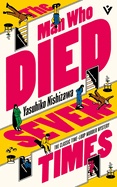
Yasuhiko Nishizawa's first novel in English, The Man Who Died Seven Times, engagingly translated by Jesse Kirkwood, arrives 30 years after its 1995 Japanese publication having lost none of its quirky charm. Other than the absence of cell phones and digital screens, Nishizawa's "classic time-loop murder mystery" remains timeless entertainment.
Sixteen-year-old Hisataro Oba is the youngest in his complicatedly dysfunctional family. Each New Year's Day--at least since a few years back--the three generations gather at wealthy Grandfather's mansion, each member color-coded in tracksuits and chanchanko jackets. After being an abusive wastrel to his three daughters--Kamiji, Kotono, Haruna--Grandfather mended his squandering ways and created a major corporation worth a staggering fortune. Only Kotono stuck around, positioning her to inherit everything. Kamiji and Haruna are maneuvering for their share, hoping to install one of Kamiji's three sons (including Hisataro) or one of Haruna's two daughters as successor. Meanwhile, Hisataro has a "troublesome 'condition' " he calls "the Trap": getting stuck in an unpredictable, loop--"one full day, from midnight to midnight"--that repeats nine times. Of course, it hits this New Year's, and Grandfather ends up dead in the second loop. Can (should?) his life be saved?
Hisataro is a delightfully chatty narrator, sharing every thought, examining every angle, explaining every option. He may be biologically 16, but his "mind is at least thirty years old... a mathematically provable fact" given his "condition." With insight and humor, this "jaded old man" guides readers to a comical "quagmire" of a finale: mysteries are solvable, families not so much. --Terry Hong

